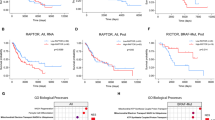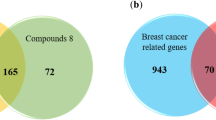Abstract
Recent studies have suggested the potency of berberine (BBR) for multiple cancer treatments, including multiple myeloma (MM). However, the direct target and underlying mechanism of BBR remain largely understood in MM. Here, we demonstrated that BBR inhibited cell proliferation and acted synergistically with bortezomib in MM.1S cells. BBR treatment induced MM cell cycle arrest by downregulating several cell cycle-related proteins. Murine double minute 2 (MDM2) as a BBR-binding protein was identified by surface plasmon resonance image (SPRi) analysis and molecular docking. Overexpression of MDM2 is associated with MM progression and a poor prognosis. Knockdown MDM2 by siRNA transfection can repress MM malignant progression and attenuate the BBR sensitivity to MM.1S cells. BBR treatment induced the degradation of MDM2 through the ubiquitin–proteasome system and reactivated P53/P21 in MM cells. Overall, our data has illustrated that MDM2, as a binding protein of BBR for the first time, may serve as a potential therapeutic option for MM.






Similar content being viewed by others
Abbreviations
- BBR:
-
Berberine
- MM:
-
Multiple myeloma
- MGUS:
-
Monoclonal gammopathy of undetermined significance
- SMM:
-
Smoldering multiple myeloma
- MDM2:
-
Murine double minute 2
- MDM4:
-
Murine double minute 4
- IL-6:
-
Interleukin-6
- SPR:
-
Surface plasmon resonance
References
Amin M, Razi M, Sarrafzadeh-Rezaei F, Shalizar Jalali A, Najafi G (2018) Berberine inhibits experimental varicocele-induced cell cycle arrest via regulating cyclin D1, cdk4 and p21 proteins expression in rat testicles. Andrologia . 2018 Feb 14
Canavese M, Santo L, Raje N (2012) Cyclin dependent kinases in cancer: potential for therapeutic intervention. Cancer Biol Ther 13(7):451–457
Deng H, Ikeda A, Cui H, Bartlett JD, Suzuki M (2019) MDM2-mediated p21 proteasomal degradation promotes fluoride toxicity in ameloblasts. Cells 8(5):436
Enge M, Bao W, Hedstrom E, Jackson SP, Moumen A, Selivanova G (2009) MDM2-dependent downregulation of p21 and hnRNP K provides a switch between apoptosis and growth arrest induced by pharmacologically activated p53. Cancer Cell 15(3):171–183
Flynt E, Bisht K, Sridharan V, Ortiz M, Towfic F, Thakurta A (2020) Prognosis, biology, and targeting of TP53 dysregulation in multiple myeloma. Cells 9(2):287
Hu HY, Li KP, Wang XJ et al (2013) Set9, NF-kappaB, and microRNA-21 mediate berberine-induced apoptosis of human multiple myeloma cells. Acta Pharmacol Sin 34(1):157–166
Haupt Y, Maya R, Kazaz A, Oren M (1997) MDM2 promotes the rapid degradation of p53. Nature 387(6630):296–299
Jovanovic KK, Escure G, Demonchy J et al (2018) Deregulation and targeting of TP53 pathway in multiple myeloma. Front Oncol 8:665
Kramer A, Schultheis B, Bergmann J et al (2002) Alterations of the cyclin D1/pRb/p16(INK4A) pathway in multiple myeloma. Leukemia 16(9):1844–1851
Kumar SK, Dispenzieri A, Lacy MQ et al (2014) Continued improvement in survival in multiple myeloma: changes in early mortality and outcomes in older patients. Leukemia 28(5):1122–1128
Landgren O, Kyle RA, Pfeiffer RM et al (2009) Monoclonal gammopathy of undetermined significance (MGUS) consistently precedes multiple myeloma: a prospective study. Blood 113(22):5412–5417
Lin CC, Lin SY, Chung JG, Lin JP, Chen GW, Kao ST (2006) Down-regulation of cyclin B1 and up-regulation of Wee1 by berberine promotes entry of leukemia cells into the G2/M-phase of the cell cycle. Anticancer Res 26(2A):1097–1104
Letasiova S, Jantova S, Cipak L, Muckova M (2006) Berberine-antiproliferative activity in vitro and induction of apoptosis/necrosis of the U937 and B16 cells. Cancer Lett 239(2):254–262
Luo X, Gu J, Zhu R et al (2014) Integrative analysis of differential miRNA and functional study of miR-21 by seed-targeting inhibition in multiple myeloma cells in response to berberine. BMC Syst Biol 8:82
Mattioli M, Agnelli L, Fabris S et al (2005) Gene expression profiling of plasma cell dyscrasias reveals molecular patterns associated with distinct IGH translocations in multiple myeloma. Oncogene 24(15):2461–2473
Palumbo A, Anderson K (2011) Multiple myeloma. N Engl J Med 364(11):1046–1060
Pandey MK, Sung B, Kunnumakkara AB, Sethi G, Chaturvedi MM, Aggarwal BB (2008) Berberine modifies cysteine 179 of IkappaBalpha kinase, suppresses nuclear factor-kappaB-regulated antiapoptotic gene products, and potentiates apoptosis. Cancer Res 68(13):5370–5379
Richardson PG, Barlogie B, Berenson J et al (2003) A phase 2 study of bortezomib in relapsed, refractory myeloma. N Engl J Med 348(26):2609–2617
Sun S, Zhang X, Xu M et al (2019) Berberine downregulates CDC6 and inhibits proliferation via targeting JAK-STAT3 signaling in keratinocytes. Cell Death Dis 10(4):274
Saha MN, Jiang H, Chang H (2010a) Molecular mechanisms of nutlin-induced apoptosis in multiple myeloma: evidence for p53-transcription-dependent and -independent pathways. Cancer Biol Ther 10(6):567–578
Saha MN, Jiang H, Jayakar J, Reece D, Branch DR, Chang H (2010b) MDM2 antagonist nutlin plus proteasome inhibitor velcade combination displays a synergistic anti-myeloma activity. Cancer Biol Ther 9(11):936–944
Tsang CM, Cheung YC, Lui VW et al (2013) Berberine suppresses tumorigenicity and growth of nasopharyngeal carcinoma cells by inhibiting STAT3 activation induced by tumor associated fibroblasts. BMC Cancer 13:619
Tisato V, Voltan R, Gonelli A, Secchiero P, Zauli G (2017) MDM2/X inhibitors under clinical evaluation: perspectives for the management of hematological malignancies and pediatric cancer. J Hematol Oncol 10(1):133
Teoh G, Urashima M, Ogata A et al (1997) MDM2 protein overexpression promotes proliferation and survival of multiple myeloma cells. Blood 90(5):1982–1992
Weiss BM, Abadie J, Verma P, Howard RS, Kuehl WM (2009) A monoclonal gammopathy precedes multiple myeloma in most patients. Blood 113(22):5418–5422
Wade M, Li YC, Wahl GM (2013) MDM2, MDMX and p53 in oncogenesis and cancer therapy. Nat Rev Cancer 13(2):83–96
Xu H, Zhang Z, Li M, Zhang R (2010) MDM2 promotes proteasomal degradation of p21Waf1 via a conformation change. J Biol Chem 285(24):18407–18414
Yang X, Huang N (2013) Berberine induces selective apoptosis through the AMPKmediated mitochondrial/caspase pathway in hepatocellular carcinoma. Mol Med Rep 8(2):505–510
Zhang Z, Wang H, Li M, Agrawal S, Chen X, Zhang R (2004) MDM2 is a negative regulator of p21WAF1/CIP1, independent of p53. J Biol Chem 279(16):16000–16006
Zhan F, Barlogie B, Arzoumanian V et al (2007) Gene-expression signature of benign monoclonal gammopathy evident in multiple myeloma is linked to good prognosis. Blood 109(4):1692–1700
Acknowledgements
This work was supported by grants from the National Natural Science Foundation of China (no. 81170496), Research Project for Practice Development of National TCM Clinical Research Bases (NO. JDZX2015119), The State Key Laboratory of Natural and Biomimetic Drugs (No. K202113) Science and Technology Program of Guangdong Province (No. 2017B 030303001), and Science and Technology Program of Guangzhou City (No. 201604020140, 202206010063). We gratefully acknowledge Guangzhou BetterWays Biotechnology and Guangzhou Fitgene Biotechnology for their assistance in molecular docking and mass spectrum. We thank the Institute of Laboratory Animal Science, School of Medicine, and School of Traditional Chines Medicine at Jinan University for equipment and technical support.
Author information
Authors and Affiliations
Contributions
JF conceived of and designed the experiments. CL and RS performed the experiments. XW, YL, JY, GH, and CG analyzed the data. ZY and CL contributed reagents, materials, and analytical tools. JF, CL, and CG wrote the paper.
Corresponding authors
Ethics declarations
Competing interests
The authors declare no competing interests.
Additional information
Publisher's note
Springer Nature remains neutral with regard to jurisdictional claims in published maps and institutional affiliations.
Supplementary Information
Below is the link to the electronic supplementary material.
Rights and permissions
About this article
Cite this article
Li, C., Su, R., Wang, X. et al. Discovery of the oncogenic MDM2, a direct binding target of berberine and a potential therapeutic, in multiple myeloma. Funct Integr Genomics 22, 1031–1041 (2022). https://doi.org/10.1007/s10142-022-00880-6
Received:
Revised:
Accepted:
Published:
Issue Date:
DOI: https://doi.org/10.1007/s10142-022-00880-6




